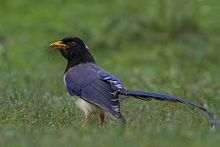Yellow-billed blue magpie
| Yellow-billed blue magpie | |
|---|---|
 |
|
| From Chopta, Uttarakhand, India | |
| Scientific classification | |
| Kingdom: | Animalia |
| Phylum: | Chordata |
| Class: | Aves |
| Order: | Passeriformes |
| Family: | Corvidae |
| Genus: | Urocissa |
| Species: | U. flavirostris |
| Binomial name | |
|
Urocissa flavirostris (Blyth, 1846) |
|
The yellow-billed blue magpie or gold-billed magpie (Urocissa flavirostris) is a passerine bird in the crow and jay family, Corvidae. It forms a superspecies with the Taiwan blue magpie and the red-billed blue magpie. The species ranges across the northern parts of the Indian Subcontinent including the lower Himalayas, with a disjunct population in Vietnam.
Length 66 cm (26 in), including tail of about 46 cm (18 in). Sexes alike. Head, neck, and breast black, with a white patch on the nape; remainder of lower plumage white, faintly tinged with lilac; whole upper plumage purplish-blue, brighter on the wings and tail; flight-feathers tipped with white, the outermost edged with the same; tail long and graduated, the feathers blue, broadly tipped with white, all except the very long central pair having a band of black in front of the white
The yellow-billed blue magpie is found throughout the Himalayas from Hazara to the Brahmaputra. It is divided into two races. Of these, U. f. cucullata is the better known and is found from the Western boundary of the range to Western Nepal, being a common species about most of the hill stations of the Western Himalayas, breeding in a zone from 1,500 to 3,000 m (4,900 to 9,800 ft). The typical form is found from Eastern Nepal eastwards and differs in that the under parts have a darker lilac tinge; its zone is slightly higher than that of the Western form, as it seldom occurs as low as 1,830 m (6,000 ft). A resident species, but during the winter months it usually deserts the higher parts of its summer zone. From Simla eastwards, the closely allied red-billed blue magpie (Urocissa erythroryncha) is often found in the same areas as the yellow-billed species; it is particularly common about Mussoorie, Tehri-Garhwal, -Kumaon, and in Nepal, and may be easily distinguished by its red beak and the greater extent of the white nape-patch.
...
Wikipedia

